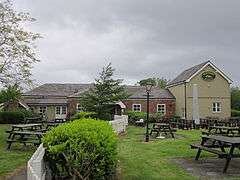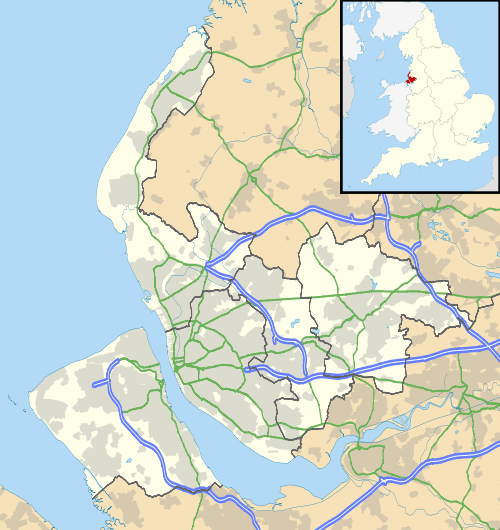Ince Blundell
Ince Blundell is a village and civil parish in the Metropolitan Borough of Sefton in Merseyside, England but historically in Lancashire. It is situated to the north of Liverpool on the A565 road and to the east of the village of Hightown. There are two associated hamlets of Lady Green and Carr Houses.
| Ince Blundell | |
|---|---|
| Village | |
 The Red Squirrel public house | |
 Ince Blundell Location within Merseyside | |
| Population | 516 (2011)[1] |
| OS grid reference | SD320034 |
| Civil parish |
|
| Metropolitan borough | |
| Metropolitan county | |
| Region | |
| Country | England |
| Sovereign state | United Kingdom |
| Post town | LIVERPOOL |
| Postcode district | L38 |
| Dialling code | 0151 |
| Police | Merseyside |
| Fire | Merseyside |
| Ambulance | North West |
| UK Parliament | |
History
Ince Blundell is probably the oldest settlement within the borough of Sefton.[2] The name Ince comes from Hinne a Celtic word meaning "island in the marsh".[2] This name bears evidence to Ince lying on a sandy ridge in the Alt valley, a place that in the past had been marshland.
In the 14th century, John Blundell, whose family were the predominant landowners in the area, added his surname to Ince. This was to distinguish it from the Ince in Cheshire and Ince-in-Makerfield near Wigan.[3] Built from 1720, Ince Blundell Hall was the home of the Blundells of Ince, who became the Weld-Blundells, until 1959. The house is a Grade II* listed building,[4] and is now a nursing home run by the Canonesses of Saint Augustine.
Governance
From 1997 until 2010 the village and civil parish of Ince Blundell was part of the Knowsley North and Sefton East constituency represented by George Howarth, a Labour Party MP. As a result of boundary revisions for the 2010 general election the Knowsley North and Sefton East constituency was abolished with Sefton East, including Ince Blundell, being merged with the northern parts of the former Crosby constituency, which was also abolished, to form the new Sefton Central constituency which is represented by the Labour Party MP Bill Esterson.
For elections to Sefton Council, the village and civil parish of Ince Blundell is part of Ravenmeols electoral ward which has three councillors. Two are members of the Formby Residents Action Group (FRAG), Bob McCann (who also sits on the Ince Blundell Parish Council), Maria Bennett, and the third councillor, Nina Killen, represents the Labour party.
Description
There are two local pubs, both on the A565 north of the village: the Weld Blundell, on Scaffold Lane; and the Red Squirrel, which is part of the Harvester restaurant chain,[5] at the junction of Scaffold Lane and Orrell Hill Lane. There is a social club located at the Village Hall. There is also a third pub, the Pheasant, a short distance away at the other end of Orrell Hill Lane at its junction with Moss Lane.
In 2006 and 2007, Ince Blundell entered the North West In Bloom competition, part of the Royal Horticultural Society's Britain in Bloom campaign.[6]
Ince Blundell Hall statues
Ince Blundell Hall was noted for the collection of marble statues from Ancient Rome and Ancient Greece, as well as 17th and 18th-century Italian sculptures by artists such as Carlo Albacini and Bartolomeo Cavaceppi. They were collected by Henry Blundell and housed first in a purpose-built Garden Temple (1792), and later in a scaled-down version of the Pantheon (1802-1804). The ancient sculptures, including some from Hadrian's Villa at Tivoli, are now located in the World Museum, Liverpool.[7][8][9] Henry Blundell also collected paintings and furniture, some of which is also at the Walker Art Gallery.[10] Henry's estranged son Charles Robert Blundell (1761-1837) made a large collection of drawings many of which are also at the Walker.[11]
See also
References
- "Check Browser Settings". Neighbourhood.statistics.gov.uk. Retrieved 17 August 2016.
- Introduction, inceblundellvillage.co.uk, retrieved 15 November 2007
- History, Blundell Hall Nursing Home, archived from the original on 24 August 2007, retrieved 15 November 2007
- Historic England. "Ince Blundell Hall (1199254)". National Heritage List for England. Retrieved 3 November 2009.
- "Find a Harvester: The Red Squirrel". Harvester. Archived from the original on 9 August 2009. Retrieved 3 November 2009.
- Village In Bloom, inceblundellvillage.co.uk, archived from the original on 19 October 2007, retrieved 15 November 2007
- "Conservation technologies, Liverpool museums". Liverpoolmuseums.org.uk. 31 August 2013. Retrieved 17 August 2016.
- "Highlighted objects, Liverpool museums". Liverpoolmuseums.org.uk. Retrieved 17 August 2016.
- "Archived copy". Archived from the original on 30 July 2012. Retrieved 2012-07-18.CS1 maint: archived copy as title (link)
- "Archived copy". Archived from the original on 19 May 2012. Retrieved 2012-07-18.CS1 maint: archived copy as title (link)
- "Shop - Exhibition books - Mantegna to Rubens, Liverpool museums". Liverpoolmuseums.org.uk. Retrieved 15 August 2016.
Further reading
- Davies, Glenys (2014). "Inscriptions as texts and objects: Approaches to epigraphic publication in the nineteenth century". Journal of the History of Collections. 26 (3): 373–386. doi:10.1093/jhc/fhu025.
External links
| Wikimedia Commons has media related to Ince Blundell. |